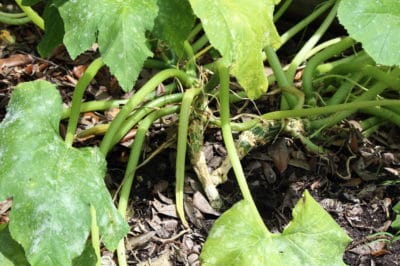Powdery Mildew
Squash plant leaves will appear as dusted with white flour when powdery mildew has infected the plant. The fungi Erysiphe cichoracearum and Sphaerotheca fuliginea are the culprits causing this disease that stunts growth and sometimes kills the plant. Growing powdery mildew resistant squash and avoiding overhead watering may prevent this disease.
Sometimes even when preventative measures are taken, the plant becomes infected with powdery mildew anyway. Here are some fungicides that may kill this disease:
- Sulfur
- Lime-sulfur
- Neem oil
- Potassium bicarbonate
Bacterial Wilt
Bacterial wilt can cause sudden wilting and death of squash plants. The bacterium Erwinia tracheiphila is spread by spotted or striped cucumber beetles. The beetles first feed on infected plants and then spread the disease to the healthy plants. The only cure for this disease is to eliminate the cucumber beetles.
Blossom-End Rot
Squash turning dark on the blossom end is an indicator of blossom-end rot. This disease occurs when the squash plant does not take up enough calcium. Here are some reasons why they do not:
- Uneven watering
- Rapid growth
- Excessive nitrogen
- Excessive potassium
Before planting squash plants, have the soil tested by your local extension office. Follow the recommendations for improving the calcium levels. Lime or gypsum are natural products usually suggested that will enrich your soil with calcium.
Anthracnose
Anthracnose is a fungal disease that attacks the leaves and fruit of the squash plant. At the beginning of the disease, the leaves develop yellowish or water-soaked spots. The spots expand turning brown then black. The wet spots then dry up and fall out leaving a hole in the leaves. Infected fruit will contain sunken canker-like spots of various sizes.
The spread of Anthracnose can be halted or controlled in a few ways. Anthracnose can live in seeds; therefore, start your squash plants with seeds from a reputable company. Plant squash in soil that did not grow cucurbit plants the previous season. Always remove and destroy the plant debris from these plants at the end of the growing season.
Mosaic Virus
Two strains of mosaic viruses (squash mosaic and zucchini yellow mosaic) can infect squash plants. Here are the symptoms of an infected plant:
- Stunted growth
- Crinkled, mottled, or light green leaves
- Fruits irregular in shape, mottled or warty
Cucumber beetles and aphids are known to spread mosaic viruses. Controlling these pests will help prevent these viruses from infecting your garden. Another solution is to grow from only certified virus free seeds.
